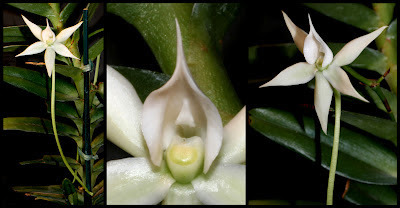This post has been submitted to the Fort Lauderdale Orchid Society for publication in the FLOS monthly newsletter.
On August 12, 2010 the Royal Horticultural Society (RHS) officially registered Angraecum Shooting Star. The originators, Hendrick and Quintus Vorster, from HQ Orchids based in South Africa had created a robust plant that had become popular with both professional growers and hobbyists before the plant was even registered. I was very fortunate and picked one up at a reasonable price fifteen months before the RHS bestowed the registration on this amazing hybrid. It was simply known as Angraecum florulentum x Angraecum eburneum ssp xerophilum.
 Angraecum Shooting Star
Angraecum Shooting Star
As it turns out, the sub-tropical climate of South Florida is very conducive for Angcm. Shooting Star. The development of the plant has been nothing short of spectacular. Whether rain fall has been extremely heavy or the lack of (which we've experienced the last two years), the plant has done very well, With an increased number of flowers through the last three blooming periods and seven new plants at the basal section of the plant.
The plant was placed in a 6 inch clay pot with ample drainage holes at the base in a mixture of equal amounts of medium pieces of coconut husks, charcoal, perlite and tree fir. A small amount of sphagnum moss was added to hold moisture. During the warmer months of early May through early October, the plant was watered every 3 days. When temperatures finally start cooling off, watering should be cut back to every 5 - 7 days. There is a dry period for both sets of parents of the hybrid. Keep the water flowing in culture and the plant will continue to grow and thrive. Try not to let water sit on the leaves where they are connected to the stem.
Fertilizer should be used once every week throughout the entire year. It is easy to dispense while doing the normal watering of the plant. A systemic fungicide applied once every four weeks, especially the bottom parts of the leaves (where most fungus will show its ugly head first). As usual, it is advantageous to keep a handy quart spray bottle with a topical fungicide in case of minor issues.
As mentioned earlier, there is a dry period for both sets of parents. Angcm. eburneum ssp. xerophilum comes from the southern end of Madagascar. It is one of the few Angraecums that grow in that semi-arid region. It primarily grows as a lithophyte in very bright light. This being the reason that its rather short for an Angcm. eburneum of any type. The stem tops off at about 30 - 35cm (12 - 14 inches tall). Angcm. florulentum, from the Comoro Islands, grows epephytically on tree trunks and in thick scrub at elevations between 600 - 1000 meters, where it drys out during cooler months. It grows to a height of 35 - 40cm (14 - 16 inches) with the thickness of the stem being 4mm (about a 1/4 inch) which is less than a third of Angcm. eburneum ssp. xerophilum (1.3cm, 9/16ths of an inch).
The leaves on Angcm. eburneum ssp. xerophilum are 13 - 15cm (5 - 6 inches long) and very thick and leathery; they hold moisture for the drier months. Those on Angcm. florulentum are not as long (8 - 10cm long, 3 - 4 inches) nor are they as thick.
Flowers from both parents are very similar in size (5 x 4cm, 2 1/4 x 1 3/4 inches), although the spur on the Angcm. florulentum is about 1 - 2cm longer (about 3/4 inch longer). Total length of the Angcm. florulentum spur is 9 - 10cm (about 4 inches).
What does all of this really mean; if you take a little of this (seed parent - Angcm. florulentum) and mix it with a little of that (pollen parent - Angcm. eburneum ssp. xerophilum) you will get the hybrid Angraecum Shooting Star. My plant looks to have the sturdiness and hardiness of Angcm. eburneum ssp. xerophilum but the height of Angcm. florulentum. The flowers appear to be a combination of both, although the spur is longer than both parents, 10 - 13cm (4 - 5 inches long) and the color of those flowers is a very pristine white. It is a very beautiful addition to my collection.
